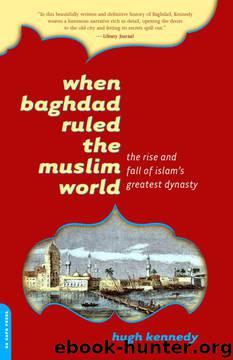When Baghdad Ruled the Muslim World: The Rise and Fall of Islam's Greatest Dynasty by Hugh Kennedy

Author:Hugh Kennedy
Language: eng
Format: epub
Published: 2010-08-19T08:48:00+00:00
VII
The Harem
he Abbasid caliphs all maintained a female household which in many ways was distinct from the male world of army, administration and the public court, although the two different spheres interacted in many different ways. Conventionally this household is described as the harem (harem) and seen as a secluded world of luxury, idleness and intermittent danger. As early as the tenth century commentators were condemning the extravagance and political influence of the harem as a major cause of the failing powers of the caliphs.'
The term harim means the protected or inviolable part of the house where only males closely related to the owner are allowed to visit. In fact the term is seldom used in the sources of the period. More commonly the caliph would refer to his huram, a plural word of the same root, meaning his women and, more generally, those under his protection. The huram was a group of people rather than a particular building or physical location.
Under the first Abbasid caliphs, the women of the ruling family seem to have maintained their own households and palaces, very much like their brothers and male cousins. By the early tenth century, if not before, there are indications that the women were more enclosed in the vast and sprawling royal palace and the harem had become a separate, purpose-built, enclosed structure, like the famous harem of the Topkapi Palace in Istanbul. In 974, when the caliphs had lost virtually all their political power, Adud al-Dawla the Buyid, now the effective ruler of Baghdad, visited the caliphal palace. He was shown round the vast complex of buildings and courtyards, much of it deserted and falling into ruin, by the chamberlain Mu'nis al-Fadl. When they came to the harem, however, Mu'nis stopped and explained that no man except an Abbasid caliph had ever been inside it, but of course, if the amir wished to see it, he could. Tactfully Adud al-Dawla declined the offer and continued the tour of the rest of the complex.2 Clearly by this time the harem was a separate, clearly defined area of the palace. It is not clear when this had come to pass. In an anecdote told to explain the fall of the Barmakids in 803, Mascudi, writing in the mid tenth century, tells of Yahya the Barmakid supervising the huram of Harun al-Rashid, and apparently locking up the gates of the huram at night and taking the keys home with him. He also forbade the women to be served by their eunuchs. This provoked the wrath of Harun's formidable wife Zubayda, who then determined to undermine the power of the Barmakid family.3 However, this looks like the back projection of later norms to the early Abbasid period, and probably tells us more about the position in the mid tenth century than in the late eighth. It is impossible from the archaeological evidence to identify any specific areas of the palaces at Samarra as the harems, although by this time (mid ninth century) there probably were separate, enclosed women's quarters.
Download
This site does not store any files on its server. We only index and link to content provided by other sites. Please contact the content providers to delete copyright contents if any and email us, we'll remove relevant links or contents immediately.
| Africa | Americas |
| Arctic & Antarctica | Asia |
| Australia & Oceania | Europe |
| Middle East | Russia |
| United States | World |
| Ancient Civilizations | Military |
| Historical Study & Educational Resources |
Empire of the Sikhs by Patwant Singh(22763)
The Wind in My Hair by Masih Alinejad(4839)
The Templars by Dan Jones(4557)
Rise and Kill First by Ronen Bergman(4544)
The Rape of Nanking by Iris Chang(4022)
12 Strong by Doug Stanton(3419)
Blood and Sand by Alex Von Tunzelmann(3055)
The History of Jihad: From Muhammad to ISIS by Spencer Robert(2504)
Babylon's Ark by Lawrence Anthony(2427)
The Turkish Psychedelic Explosion by Daniel Spicer(2245)
No Room for Small Dreams by Shimon Peres(2235)
Gideon's Spies: The Secret History of the Mossad by Gordon Thomas(2231)
Inside the Middle East by Avi Melamed(2230)
Arabs by Eugene Rogan(2193)
The First Muslim The Story of Muhammad by Lesley Hazleton(2153)
Bus on Jaffa Road by Mike Kelly(2034)
Come, Tell Me How You Live by Mallowan Agatha Christie(2024)
Kabul 1841-42: Battle Story by Edmund Yorke(1921)
1453 by Roger Crowley(1879)
